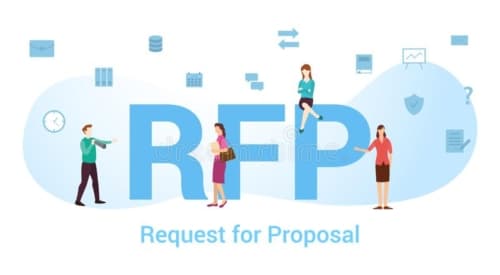Solar Request For Proposal
A solar request for proposal outlines the photovoltaic (PV) product or service requirements, the contract terms, and bidding process. Once the proposals are received, they are evaluated according to the goals of the issuing agency and a vendor is selected.
What is a request for proposal?
A request for proposal (RFP) is a document used by a business, non-profit, or government agency early in the procurement process to announce a project and its requirements to potential vendors. The document solicits proposals from the potential vendors through a bidding process.
RFPs are commonly used for projects that require technical expertise, specialized capability, or for products and services that do not yet exist. The RFP documents are a crucial part of the procurement process for an organization interested in purchasing a service or product.
Essentially, an solar RFP:
- Announces a product or service that a customer wants to procure.
- Provides requirements for the product or service.
- Confirms that the customer will use a competitive selection process.
- Ensures that vendors address the specified requirements.
- Follows a structured evaluation and selection process so that the customer can demonstrate impartiality.

The solar RFP Process
The purpose of the solar RFP is to provide business leaders with the information they need to make informed strategic decisions. The solar RFP process includes the steps listed below:
- Determine if an solar RFP is the correct procurement tool – There are solicitation alternatives to solar RFPs, including Invitations for Bid, Requests for Information, and Requests for Quotation, among others. It’s worth investigating these alternatives as they differ in terms of cost, complexity, requested products, services, or outcomes.
- Gather solar RFP requirements – The quality of an solar RFP and its outcome depend on the requirements. Meet with stakeholders to capture the business requirements considering purpose, goals, evaluation criteria, and nice-to-haves.
- Develop and administer the solar RFP – While every solar RFP has questions, to simplify evaluation, reduce the number of questions. Shorter solar RFPs attract vendors and simplify vendor selection.
- Conduct an initial evaluation of proposals – Conduct a preliminary evaluation to create a shortlist of qualified vendors by comparing critical factors against vendor strengths.
- Contact shortlisted vendors – Create a shortlist of vendors by asking them in-depth questions about critical factors, evaluating their bids using scores, and requesting a presentation or demo.
- Select the winning bid – With input from business stakeholders, select the winning bid by comparing proposals with the evaluation criteria created in step 2.
- Create and complete the contract – After selecting the winning vendor, create and sign the contract, which should include a statement of work with milestones, performance metrics, and a review process.
Best Practices for solar RFPs
While solar projects can vary by size, location, equipment, and goals, there are five best practices to keep in mind for your solar RFP:
- Start with a clear goal to help develop the solar RFP and to evaluate the proposals.
- Focus on system performance outcomes rather than on specific technical or equipment requirements. This will give vendors the freedom to exercise creativity in their system design. Of course, the solar RFP should require that vendors select certified equipment.
- Simplify the evaluation process by specifying requirements you would like vendors to address like including a utility bill escalator in financial modeling, for example.
- Provide vendors with site information to help them address specific needs in their proposals.
- To attract the greatest number of vendors, disseminate your solar RFP as widely as possible.
Solar RFP roles and responsibilities
Managing a successful solar RFP requires collaboration and coordination as a variety of stakeholders must identify a business need, gather information, and explore possible solutions.
By defining and documenting roles and responsibilities, your organization can run an effective solar request for proposal. Key players in the solar RFP process can include:
Business stakeholders include the team requesting the purchase or solution. Stakeholders may help determine what the solution should accomplish. They may also help evaluate and score the solar RFP responses.
The solar RFP manager is responsible for understanding the business’ needs and explaining those needs within the solar RFP. They are also responsible for assessing vendor qualifications, communicating with vendors during the solar RFP process, and selecting qualified vendors. BCSC LLC can serve as your third party solar RFP manager during this process.
The Chief Financial Officer (CFO) evaluates costs and return on investment (ROI) to determine whether a solution is financially viable.
Contact Us!
BCSC LLC can run a competitive request for solar proposal from thousands of qualified nationwide solar & storage providers for your organization. Inquire today: info@beachcitiessolarconsulting.com

